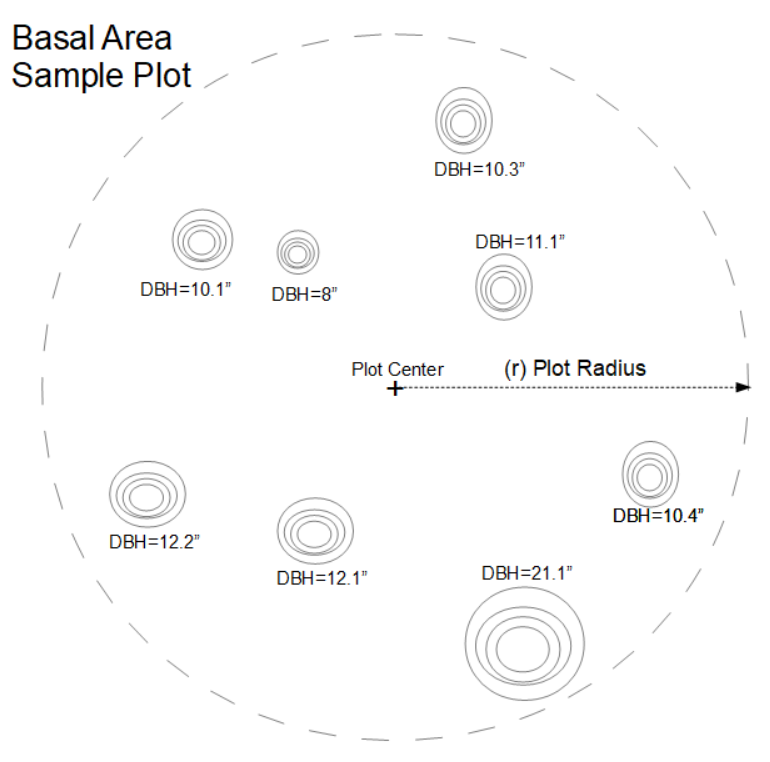Tree Basal Area per Acre
The Tree Basal Area per Acre calculator computes the Stand Density, which is the basal area per acre of trees based on a sample of tree breast high diameters in a plot and the plot radius.
INSTRUCTIONS: Choose units and enter the following:
- (DBH) Diameter at Breast Height samples in inches (e.g., 10.1,8.0,10.3,11.1,12.2,12.1,21.1,10.4)
- (r) Plot Radius. Note: the default radius is for an 1/10th of an acre sample ring.
- (PN) Plot Name. This is the sample name if desired for reporting.
Tree Basal Area per Acre (TBA): The basal area density is returned in square feet per acre (ft2/ac) and square meters per hectare (m2/ha). The calculator also returns the Basal Area (BA) for the Plot, the size of the plot (A) and the sample size (n).
The Math / Science
The basal area of a tree is a measure of the cross-sectional area of a tree trunk at breast height (typically 1.3 meters or 4.5 feet above the ground). It is commonly used in forestry to estimate the density of trees in a given area, assess forest stand structure, and calculate timber volume.
The basal area of a tree is calculated using the formula for the area of a circle:
BA = π ⋅ DBH2/4
where:
- BA = Basal Area of a tree at breast height
- DBH = Diameter of a tree at breast height (DBH).
Unit Conversion
Basal area is often expressed in square feet per acre (ft2/ac) and square meters per hectare (m²/ha) when assessing forest stands.
Importance in Forestry:
Basal area is used to estimate the volume of timber that can be harvested. Basal area helps in assessing the health and productivity of a forest stand. It is used in forest management practices to determine thinning and other treatments. By summing the basal areas of individual trees in a sample plot, foresters can estimate the total basal area per hectare, which is an important indicator of forest density and stand structure.
Forestry Calculators
- Tree Basal Area from Diameter: Computes the basal area of a tree based on the measurement of the tree's diameter at breast height.
- Tree Basal Area from Circumference: Computes the basal area of a tree based on the measurement of the tree's circumference at breast height.
- Basal Area per Acre: Computes the basal average per acre (ft2/ac) and basal average per hectare (m2/ha), based on samples and plot size.
- Volume of Maple Syrup from Sap: Computes the amount of maple syrup produced from an amount of sugar maple sap.
- Value of Maple Syrup Harvest: Computes the dollar amount associated with a number of sugar maple tree taps.
- Acreage Sample Ring: Compute the radius of a circle (e.g., 37 ft) where the area of the circle equates to an input area (e.g., 1/10th acre)
- Square Meters to Acres: Converts square meters to acres.
- Simple Stats: Computes the most common observational statistics (min, max, mean, sd, sum, sort etc) for a set of comma separated numbers.
Reference
- Basal Area: A Measure Made for Management by Jim Elledge and Becky Barlow
Special Thanks
Special thanks to Luke Macaulay of the University of Maryland
Collections
- Comments
- Attachments
- Stats
No comments |

